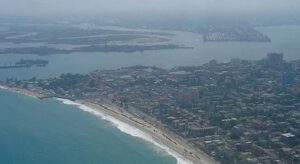 The Lagos State Government has announced plans to expand the use of groyne technology along its 180-kilometer coastline to combat the escalating threat of coastal erosion. Commissioner for Waterfront Infrastructure Development, Ekundayo Alebiosu, disclosed this initiative during a ministerial press briefing on May 19, 2025. The project aims to implement sustainable shoreline protection and secure waterfront communities from environmental degradation.
The Lagos State Government has announced plans to expand the use of groyne technology along its 180-kilometer coastline to combat the escalating threat of coastal erosion. Commissioner for Waterfront Infrastructure Development, Ekundayo Alebiosu, disclosed this initiative during a ministerial press briefing on May 19, 2025. The project aims to implement sustainable shoreline protection and secure waterfront communities from environmental degradation.
Groyne structures, which interrupt water flow and help retain sediment, are already in use in some parts of Lagos. However, Alebiosu noted that scaling up the deployment to cover the entire coastal stretch would cost over ₦3 trillion, highlighting the need for strategic partnerships. He emphasized that the state cannot handle the project alone and requires collaboration with the Federal Government and the private sector.
To explore effective coastal protection strategies, Alebiosu recently led a state delegation on a working visit to the Netherlands, a global leader in coastal engineering. Lagos is considering adapting the Dutch model, which includes integrating groynes with sand nourishment and nature-based solutions for long-term resilience. This initiative aligns with Governor Babajide Sanwo-Olu’s broader agenda to protect lives and property while unlocking the economic potential of Lagos’ waterfronts.
The government is pursuing a Public-Private Partnership (PPP) framework to finance and implement the project, while also seeking technical cooperation from international bodies. Alebiosu warned that if left unchecked, erosion could devastate entire communities, harm livelihoods, and threaten public and private infrastructure.
In a related development, Alebiosu revealed that a long-standing land dispute involving residents on government schemes had been resolved peacefully. Over 200 settlers, who had encroached on state land, were spared eviction after a regularization process allowed them to legalize their occupancy, reflecting the governor’s commitment to humane governance.
Source: Nature news

